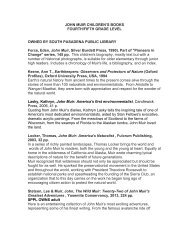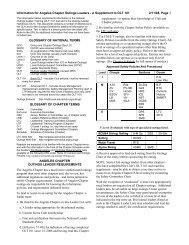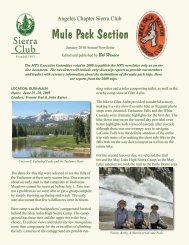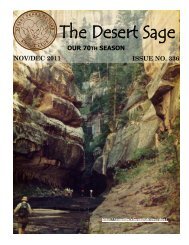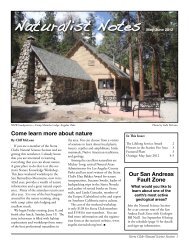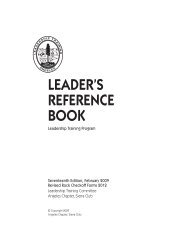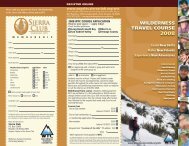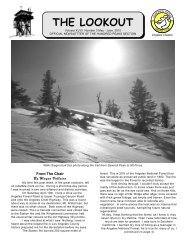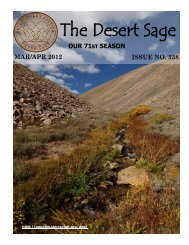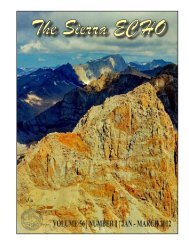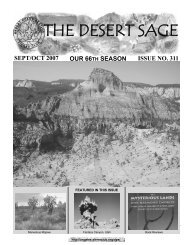The Sierra Echo - Sierra Club - Angeles Chapter
The Sierra Echo - Sierra Club - Angeles Chapter
The Sierra Echo - Sierra Club - Angeles Chapter
Create successful ePaper yourself
Turn your PDF publications into a flip-book with our unique Google optimized e-Paper software.
Chimborazo is the highest peak in the Americas north of Peru.<br />
“Starting down about 10 a.m., our descent goes well<br />
until we approach the overhanging ice. Mike, concerned<br />
with possible avalanches, opts to plow a new trail<br />
below our ascent route in the now sun-softened snow.<br />
With Mike leading my rope team, me in the middle and<br />
Charlie at the end, snow balls up in my crampons and,<br />
losing my footing, I slide 30 or 40 ft. down the mountain<br />
before being arrested by my companions. Front pointing<br />
back up the slope is woefully exhausting. My summit<br />
exultation turns to chagrin.”<br />
Two other interesting aspects of out descent: 1) We<br />
encountered a greenhouse effect after entering a layer<br />
of clouds at the 17,000’ level. It felt like a sun lamp<br />
beating down on my Gortex jacket; 2) Still in the cloud<br />
at the end of a long glissade, we lost sight of the hut<br />
Voices coming from the lodge helped us locate the<br />
building.<br />
That afternoon, although everyone was thouroughly<br />
bushed, we hiked down to the van and drove, via Ambato,<br />
to Baños, a town famous for its thermal springs, situated<br />
near the base of Tungurahua in the Cordillera Oriente.<br />
Tungurahua (16,480’), the third and last on our list of<br />
peaks to be climbed, is one of the most active volcanoes<br />
in Ecuador. In fact, volcanic action has been ongoing<br />
ever since 1999, including major eruptions in August<br />
2006, February 2008, May 2010, December 2010 and<br />
April 2011. <strong>The</strong> volcano’s eruptions are classified<br />
as strombolian in nature, i.e, accompanied by strong<br />
explosions, pyroclastic flows, and sometimes lava<br />
flows.<br />
<strong>The</strong> German explorers Alphons Stübel and Wilhelm<br />
Reiss, in February 1873, were the first to climb<br />
Tungurahua.<br />
<strong>The</strong> next day, January 17, thankfully, was a rest day.<br />
We drove through lush jungle, down alongside the Rio<br />
Pastaza, a headwater of the Amazon, where we walked<br />
over a suspension foot bridge crossing the muddy,<br />
raging river.<br />
On January 18, 1982—coincidentally my 46 th birthday—<br />
we left much of our gear at our hotel, the Sangay,<br />
drove to Tungurahua’s nearby trailhead, and began a<br />
long slog to a hut located at the 12,000’ level. Passing<br />
several small farms early in our climb, in mid morning<br />
we stopped at country store where my climbing mates<br />
presented me with a granola bar with a lit candle on the<br />
top. Nice. Thanks guys.<br />
Shortly thereafter, we came to a shanty where we found<br />
a man willing to rent us donkeys to carry our loads to<br />
the hut above. Steve and I gladly accepted the offer.<br />
“In the early afternoon, as my energy flags, we leave<br />
the last of the farms behind and enter a zone of heather,<br />
ferns and blue bonnet-like flowers which are in full<br />
bloom. <strong>The</strong> trees become moss-covered. About 4 p.m.,<br />
shades of glory, we reach the 12,000’ hut. Six-thousand<br />
feet of gain—Rabbit Peak all over again.”<br />
Next morning, Tuesday, January 19, we got off to a 4<br />
a.m. start. Wearing my new plastic boots climbing the<br />
steep, rocky terrain was difficult. I was delighted when<br />
we finally arrived at the snow line and I was able to<br />
strap on my crampons.<br />
“We arrive at the 16,480’ summit about 9 a.m. and are<br />
greeted with a grand panorama of volcanoes. (From north<br />
to south: Pichincha, Cotopaxi, Illiniza, Chimborazo,<br />
El Altar, Sangay). To the east the Amazonian Basin is<br />
covered with fluffy cumulus clouds. Spectacular is the<br />
word.”<br />
On our descent, we stopped at the same country store<br />
that we’d patronized on the way up, where we—believe<br />
it or not—along with some locals, played three games<br />
of volleyball. “We play with vigor because the losing<br />
team is meant to buy jugo de cano (sugar cane juice) for<br />
the winning team in Baños.”<br />
Alas, the cane juice was our downfall. <strong>The</strong> juicing<br />
machine was covered with flies and the juice itself was<br />
served in ice-filled glasses. Employing unusually good<br />
judgment, I declined to try it, but Steve did, and for our<br />
remaining three days in Ecuador he was reluctant to be<br />
out of sight of a bathroom.<br />
Except for the juice incident, however, Steve and I<br />
had a great time in Ecuador. Here’s hoping that his<br />
trip in Nicaragua with Nathan will hold as many fond<br />
memories for him as my trip in Ecuador with him still<br />
holds for me.<br />
<strong>The</strong> <strong>Sierra</strong> <strong>Echo</strong> 23



